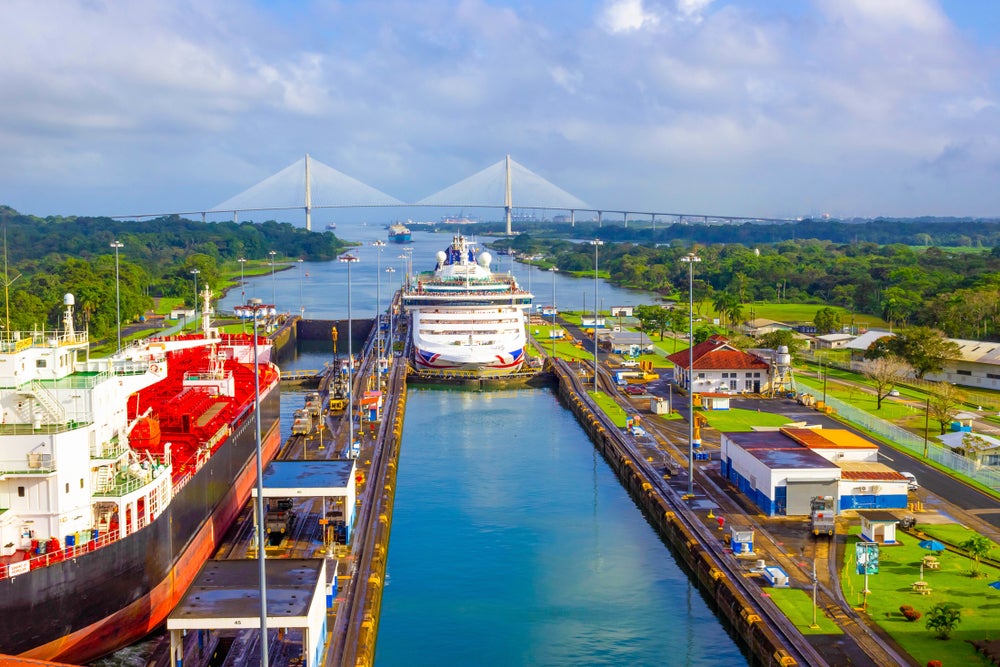The Panama Canal Authority (APC) introduced water-saving and conservation measures at the start of the 2023 dry season, reducing its capacity to 32 vessels a day since 30 July 2023.
Other measures included using water-saving basins and cross-filling locks. However, despite these steps, the APC says the level of water in Gatun Lake “has continued to decline to unprecedented levels for this time of year”.
The ACP says recorded rainfall for October 2023 was the lowest on record since 1950.
In an advisory statement, the ACP said: “Based on the rainfall projections for the following weeks, which as of today is expected to be 38% less for the rest of the year, the ACP finds it necessary to further reduce the daily transit capacity to postpone the need for additional draft reductions below the current 13.41m.”
Between 3 and 6 November 2023, the number of shipping slots on the canal will reduce from 32 vessels to 25. Between 7 November and 30 November, this will reduce again to 24 vessels a day.
In December 2023, this will reduce to 22 vessels a day, and in January 2024 it will decrease again to 20 vessels a day.
From 1 February 2024 – and until further notice – just 18 vessels a day will be able to pass through the canal.
The Panama Canal connects the Atlantic and Pacific oceans, using a system of locks, fed by water from nearby Gatun Lake, which is filled by rainwater.
The APC says the canal is used by up to 14,000 ships each year, serving more than 180 maritime routes and 1,920 ports across 170 countries.
Dr. Sheng Lu, associate professor of fashion and apparel studies at the University of Delaware tells Just Style that the Panama Canal is an important shipping route for the apparel supply chain.
"The Panama Canal is critical for many US fashion companies as it provides a shorter route for vessels traveling between the Atlantic and Pacific Oceans. Some imports from Asia go through the canal as well as US textile exports to South America, Asia and other world regions," Dr. Lu says.
In September, the National Retail Federation said that previous restrictions, imposed in summer 2023, had not posed the threat that some had initially feared.
However, with the busy festive period now on the horizon, there are some concerns about how these restrictions could impact apparel supply chains.
The APC says that it “strongly encourages” vessels to use its reservation system in order to guarantee a transit date through the canal and reduce the possibility of delays.
According to the ACP’s data, at the time of writing the average delay for vessels that had not booked a slot in the last 28 days was 2.5 days northbound and 2.4 days southbound.
AAFA’s president and CEO Steve Lamar tells Just Style: “The drought in the Panama Canal is spotlighting twin concerns affecting our world today – fragile supply chains still recovering from pandemic shocks and the worsening climate crisis.”
Lamar adds: “The Panama Canal is a critical channel for the efficient delivery of holiday goods, particularly as companies look to diversify logistics corridors away from the west coast. Restrictions on the number of ships and transit delays expose shippers and consumers to significant costs at a time of inventory struggles and high inflation in our sector. Moreover, these acute environmental realities reinforce the importance of the industry, in collaboration with other stakeholders, to accelerate efforts to mitigate environmental impacts and our operational risks.”
Robert P Antoshak, partner at Gherzi Textile Organisation, says delays in the Panama Canal could cause delays for apparel companies – and increase costs.
“Any slowdown in the ability of the Panama Canal to handle shipping traffic will have significant ramifications for regional trade,” Antoshak tells Just Style. “The canal struggles with handling its current capacity; the drought only compounds the problems. As almost half of all US container traffic traverses the Panama Canal, disruptions will not only result in delays but higher costs for companies at a time when economic uncertainties complicate sourcing decisions.”
Dr. Lu also says the delays might mean that, in some cases, fashion companies will have to explore alternative and more expensive shipping routes, which will further increase costs.
However, Dr. Lu also believes that the Panama Canal restrictions could also push apparel brands to think more carefully about their supply chains and the threat posed to them by climate change.
"In the medium to long term, incidents like this could encourage fashion companies to diversify their sourcing base, mitigating the unpredictability of supply chain disruptions," Dr Lu adds. "Conversely, such incidents serve as a reminder of the increasing threat that climate change poses to fashion companies' sourcing and supply chain operations.”









